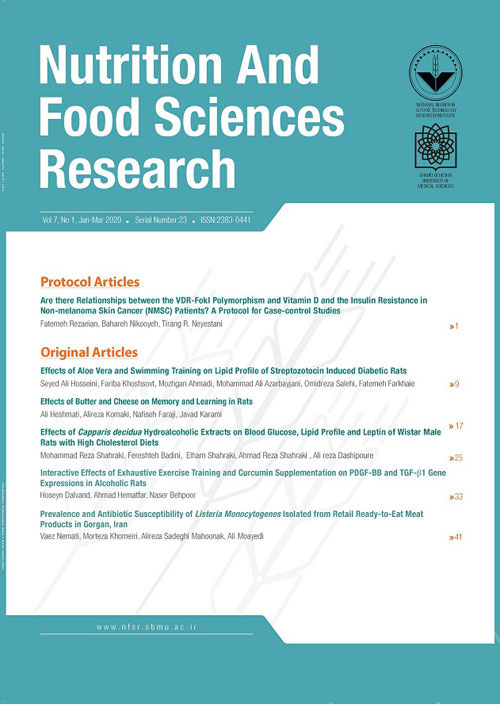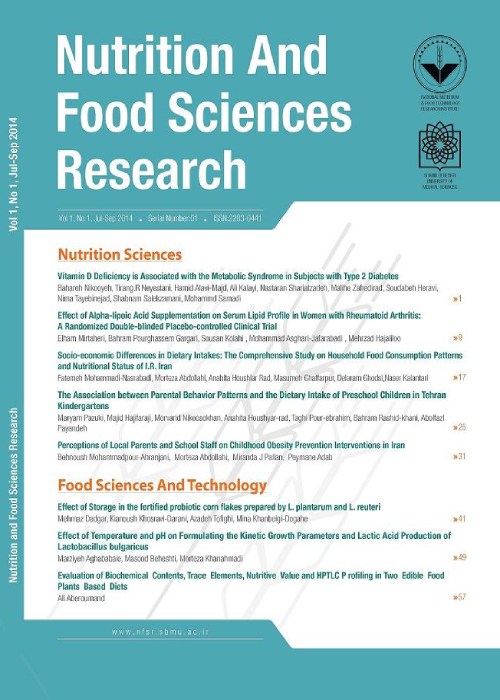فهرست مطالب

Nutrition & Food Technology Research
Volume:7 Issue: 2, Apr-Jun 2020
- تاریخ انتشار: 1398/12/11
- تعداد عناوین: 6
-
-
Pages 1-12
Based on the effects of coffee and caffeine, in particular, a review study is needed to investigate associations between the caffeine consumption and its health-linked effects. Furthermore, effects of coffee on sport performance have not fully been elucidated. Based on the increased popularity of the cold-brew coffee, this study has provided a comprehensive overview of the effects of cold-brew coffee on health and exercise performance. Databases (PubMed, Science Direct and Google Scholar) were searched for articles on human models. Totally, 2805 articles were identified from 2000 to 2020. Keywords included coffee, caffeine, cold brew, exercise, training and sports performance. Studies involving caffeine-suppressing drugs and animal studies and cases with physical limitations were excluded and thus 84 articles were identified. Results showed that consumption of 3 to 4 cups of coffee (300–400 mg/day) was associated with decreased risk factors of cancers, cardiovascular diseases, diabetes and Alzheimer disease. It is noteworthy that caffeine intake in specific groups, particularly in women, needs special consideration. However, health benefits of the cold-brew coffee seem to be greater due to the drink low acidity and high antioxidant activity. In this study, the most important factor included decreases in chlorogenic acid. Moreover, consumption of cold-brew coffee in warm weather prevented hyperthermia. In fact, 3–9 mg/kg of caffeine improved physical performance in resistance and endurance exercises. Caffeine consumption could increase lipid oxidation in aerobic exercises as well as stimulate sympathetic nerves in anaerobic exercises. However, investigation of the acute and chronic effects of consuming coffee in various contexts to achieve integrated results needs further investigations.
Keywords: Coffee, Caffeine, Health, Cold brew, Sports performance -
Pages 13-19Background and Objectives
Alcohol consumption has many health side effects. It is well known male gender is a serious risk factor to be an alcohol consumption and finding a way to reduce these complications in the short term is essential. The aim of this study was to investigate the interaction effects of aerobic exercise and curcumin on LH, FSH, Ts and GnRH following alcohol-induced rats.
Materials and Methods30 adult male Sprague Dawley rats with weighting 220-250 g and 8 weeks of age were obtained for this study, and randomly assigned into five groups (n=6) including: Dextrose-Saline control (Dext-Con), ethanol-control (Eth-Con), ethanol–curcumin (Eth-Cur), ethanol-swimming training (Eth-SWT) and ethanol–SWT+curcumin (Eth-SWT+Cur). The project duration consisted of 4 days of addiction, 6 days of quitting, 14 days of swimming training (60 min/day) and curcumin (50 mg/kg) interventions, and finally animal sacrificed. Blood sample was collected and LH, FSH, Ts, and GnRH level were measured by using ELISA (enzyme-linked immunosorbent assay) kit. Analysis of variance (ANOVA) was performed using SPSS version 21.
ResultsIn the Eth-Con group, alcohol reduced the level of LH, FSH, Ts, and GnRH compared to other specially the Dext-Con group (p=0.001). In the Eth-SWT+Cur group, significantly increased of these hormones was observed (p=0.001). Exercise alone had no significantly effect on FSH and GnRH level.
ConclusionsLikely curcumin along exercise could improve HPG axis biomarker after a decline due to excessive alcohol consumption in rat. Lack of exercise effect alone can be due to Exercise-induced oxidative stress.
Keywords: Alcohol drinking, HPG axis, LH, FSH, GnRH, Testosterone, Aerobic exercise, Curcumin -
Pages 21-28Background and Objectives
The aim of this study was to investigate possible effects of quercetin supplementation on oxidative stress, blood pressure, aerobic power, concentric pathologic hypertrophy and cardiac function in men with hypertension and coronary artery disease (CAD) after percutaneous coronary intervention (PCI).
Materials and MethodsThe present study was a randomized, double-blind clinical trial; in which, 24 men with hypertension and CAD after PCI (aged 40–60 years) were participated. Patients were prescribed quercetin (250 mg/day) or placebo for two months. Plasma total antioxidant capacity (TAC) and malondialdehyde (MDA) were assessed using colorimetric methods as well as left ventricular diastolic dysfunction (LVDD), p wave depression (PWD), ejection fraction (EF) and E/A using echocardiography and WRp using Storer-Davise cycle test. Systolic and diastolic blood pressures were measured before and after the intervention. Data were analyzed using ANCOVA and paired-sample T-test.
ResultsSupplementation resulted in a significant improvement in oxidative stress reduction (TAC increased and MDA decreased), systolic and diastolic blood pressures, systolic (EF) and diastolic (E/A) functions and aerobic power, compared to pretest and placebo groups following eight weeks of treatment (p < 0.05). A small decrease in RWT was seen in quercetin group at the end of intervention with no statistical significance (p > 0.05). The RWT was not significantly different between the quercetin and placebo groups (p > 0.05).
ConclusionsQuercetin supplementation can improve oxidative stress, blood pressure, left ventricular function and aerobic power in men with hypertension and CAD after PCI. However, this includes no effects on concentric pathologic hypertrophy. Further studies are necessary to verify effects of quercetin supplementation on left ventricular hypertrophy in humans.
Keywords: Quercetin, Oxidative stress, concentric pathologic hypertrophy, Left ventricular function, blood pressure, CAD -
Pages 29-36Background and Objectives
Shrimps (Litopenaeus vannamei) include high market prices and nutritional values; therefore, they are important aquatic resources worldwide. However, the shelf life of shrimps is limited due to microbiological deterioration during their storage. In recent years, several methods have been used to improve the quality of shrimps during cold storage. One of the most important methods includes use of edible coatings. Therefore, the objective of this study was to assess effects of active edible coatings from quince seed mucilage and green tea extract (as an antimicrobial antioxidant compounds) on physicochemical and quality properties of shrimps during cold storage.
Materials and MethodsThis study assessed effects of quince seed mucilage (QSM) coating combined with green tea extract (GTE) on color, pH, total volatile basic nitrogen (TVB-N), texture and microbial quality of the Pacific white shrimps (Litopenaeus vannamei) within 10 days of cold storage.
ResultsResults showed that pH and TVB-N values significantly increased (p<0.05) in shrimps treated with QSM coating combined with GTE. Hardness and springiness of the shrimps were improved by increasing the concentration of GTE, compared to controls. Total aerobic plate counts of the shrimps treated by QSM coating combined with GTE were lower than those of controls. The total color difference (∆E) of the controls was lowest than that of other treatments at the end of the storage time. The a* value of the shrimps decreased from -0.87±0.21 to -5.05±1.08 (showing the attitude to greenness) and the b* values increased from 1.44±0.84 to 16.47±1.61 (showing the attitude to yellowness).
ConclusionsThese results have suggested that the QSM and GTE coating can decrease spoilage and decomposition that cause quality loss of shrimps.
Keywords: Quince, Green tea, Shrimp, Bioactive coating, Microbial activity -
Pages 37-46Background and Objectives
Due to the health concerns of people about caffeine, several techniques have been developed to remove caffeine from tea; however, these techniques include limitations. The objective of the present study was to remove caffeine from dried tea leaves using hot water treatment.
Materials and MethodsHot water treatment was used to decaffeinate green and black tea leaves using two stages of brewing. Caffeine of the tea infusions was extracted using liquid–liquid extraction technique and quantified using high performance liquid chromatography. Furthermore, pH, total polyphenol content and antioxidant activity were assessed using electronic pH meter, Folin-Ciocalteu method and ABTS method, respectively. Sensory evaluation was carried out using 5-point hedonic scale test. Tea infusions were prepared within two stages of brewing at 1, 3 and 5 min as primary and 7 min as total brewing times.
ResultsAfter 3 min of primary brewing time, decaffeination rates of Ceylon black, China green and Iranian green teas were assessed as 47.7, 81.55 and 85.99%. Antioxidant activity of these samples included 87.7, 85.99 and 81.55%, while total polyphenol content included 83.03, 44.44 and 37.7%, respectively. In general, pH and total polyphenol content of decaffeinated tea-mint infusions increased significantly.
ConclusionsEffects of brewing time on caffeine concentration of the tea infusions were revealed in this study. In conclusion, hot water treatment is a safe method and includes a high efficiency for the decaffeination of green and black teas.
Keywords: Tea, Caffeine, Polyphenols, Mint Leaf, HPLC -
Pages 47-58Background and Objectives
Walnut is a nutrient with green husks containing pectin. Extraction of this pectin is valuable due to economic and environmental aspects.
Materials and MethodsEffects of three variables of pH values (1, 1.5 and 2), extraction temperatures (60, 70 and 80 °C) and process times (60, 90 and 120 min) were assessed on extraction efficiency rate, esterification degree and galacturonic acid of pectin extracted from walnut wastes using response surface statistical method. Furthermore, total ash, MW, emulsifier, rheological and Fourier transform infrared spectroscopy assessments were carried out on optimum samples.
ResultsBased on the results, optimum conditions for pectin extraction from walnut green husks with the highest extraction efficiency rate (25.76%), esterification degree (54.28%) and galacturonic acid (64.49%) were associated to pH 1.75, process temperature of 80 °C and extraction time of 120 min. The most emulsion stability of the walnut waste of pectin was seen at 4 °C and on the first day of storage. Under optimal extraction conditions, MW of the walnut green husks was 38.88 kD. Optimum sample solution of the extracted pectin exhibited viscous and pseudoplastic behaviors.
ConclusionsFourier transform infrared spectroscopy spectral diagrams of the optimal pectin samples have shown presence of galacturonic acid; thus, walnut wastes can be used as a rich source of pectin.
Keywords: Walnut green husk, Pectin, Esterification degree, Galacturonic acid


